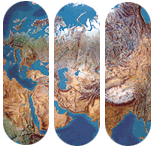|
Yazd يزد
Sulle orme di Tamerlano
|
|||
|
Yazd su wikipedia in italiano. Marco polo a Yazd (da wikipedia in inglese)
OLD CITY
بافت قديم Follow our walking tour (p 180 ) or just wander around; you’ll discover covered walkways, simple courtyards, ornate wooden doors and some lovely adobe architecture. And be sure to get yourself to the rooftops at some point for fi ne views over Yazd and into the vast brown expanses of the desert.
Masjed-e Jameh
مسجد جامع MOSQUE
Bagh-e Dolat Abad
باغ دولت آباد HISTORIC BUILDING, GARDENS
FBogheh-ye Sayyed Roknaddin بقعه سيد رکن الدين SHRINE (Mausolem of Sayyed Roknaddin; off Masjed-e Jameh St; h8am-1pm & 4-8pm Sat-Thu, 10am noon Fri) The beautiful blue-tiled dome of the tomb of local slamic notable Sayyed Roknaddin Mohammed Qazi is visible from any elevated point in the city. Built 700 years ago, the dome is fairly impressive but the deteriorating stucco inside and other decoration remain more so. The door is often closed but a knock should bring the caretaker.
Khan-e Lari خانه لاری HISTORIC BUILDING
(admission ; h7am-6pm, to 8pm summer) This
150-year-old building is one of the best-preserved Qajar-era houses in Yazd.
Alexander’s Prison زندان اسکندر HISTORIC BUILDING (Zaiee Sq; admission ; h8am-sunset, 8am-1pm & 4pm-sunset summer) This 15th-century domed school is known as Alexander’s Prison because of a reference to this apparently dastardly place in a Hafez poem. Whether the deep well in the middle of its courtyard was in fact built by Alexander the Great and used as a dungeon seems doubtful, no matter what your guide tells you. The building itself is worth a look for the small display on the old city of Yazd, the clean toilets and the mercifully cool subterranean teahouse. The early-11th-century brick Tomb of the 12 Imams is almost next door to Alexander’s Prison. The once-fi ne (but now badly deteriorated) inscriptions inside bear the names of the Shiite Imams (see the boxed text, p 302 ), though none are actually buried here.
Amir Chakhmaq Complex مجموعه امير چخماق RELIGIOUS
(Amir Chakhmaq Sq; admission US$0.30;
h7.30am-2.30pm Sat-Thu) The stunning threestorey facade of this Hosseinieh makes
it one of the largest such structures in Iran. Its rows of perfectly
proportioned sunken alcoves are at their best, and most photogenic, around
sunset when the light softens and Underneath the complex is a bazaar where kababis specialise in jigar (grilled liver). In front of the Hosseinieh, look out for the huge wooden palm nakhl, an important centrepiece once used for the observance of the Shiites’ passionate Ashura commemorations.
Saheb A Zaman Club Zurkhaneh زور خانه صاحب الزمان ZURKHANEH (admission ; hworkouts 6am, 6pm & 8pm Sat-Thu) Just off the north side of Amir Chakhmaq Sq is the Saheb A Zaman Club Zurkhaneh, which is worth seeing both for its Iranian brand of body building and because it’s a quite an amazing structure. The modern club is inside a cavernous ab anbar (water reservoir) built about 1580. Looking like a 29m-high standing egg from the inside, and crowned with fi ve burly badgirs, the reservoir stored water for much of the town. The hour-long workouts in the Zurkhaneh are an interesting window on Iranian culture; see (p 292 ). Note: only males are admitted.
ZOROASTRIAN SITES اماکن زرتشتی Ateshkadeh آتشکده FIRE TEMPLE (Sacred Eternal Flame; Kashani St; admission US$0.90; h8am-noon & 3-6pm Sat-Thu) Zoroastrians come from around the world to see this ateshkadeh, often referred to as the Zoroastrian Fire Temple and said to have been burning since about AD 470. Visible through a window from the entrance hall, the flame was transferred to Ardakan in 1174, then to Yazd in 1474 and to its present site in 1940. Above the entrance you can see the Fravahar symbol.
Dakhmeh-ye Zartoshtiyun برج خاموشی HILL (Towers of Silence; h24hr) These evocative Zoroastrian Towers of Silence are set on two lonely, barren hilltops on the southern outskirts of Yazd. They haven’t been used since the 1960s. At the foot of the hills are several other disused Zoroastrian buildings, including a defunct well and a water cistern and two small badgirs. The modern Zoroastrian cemetery is nearby. The easiest way to get here is by taxi dar baste return, including waiting time of 45 minutes or so while you climb to the top of the towers and back. |
||
|
|||

